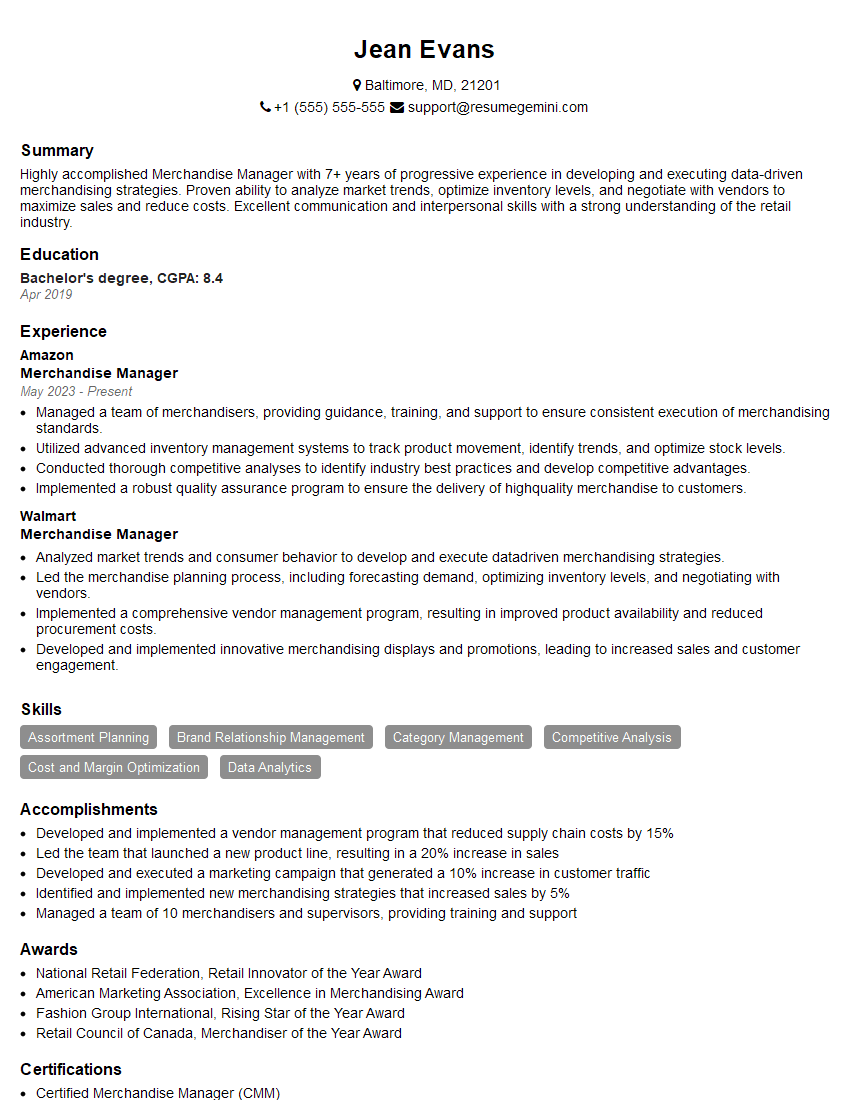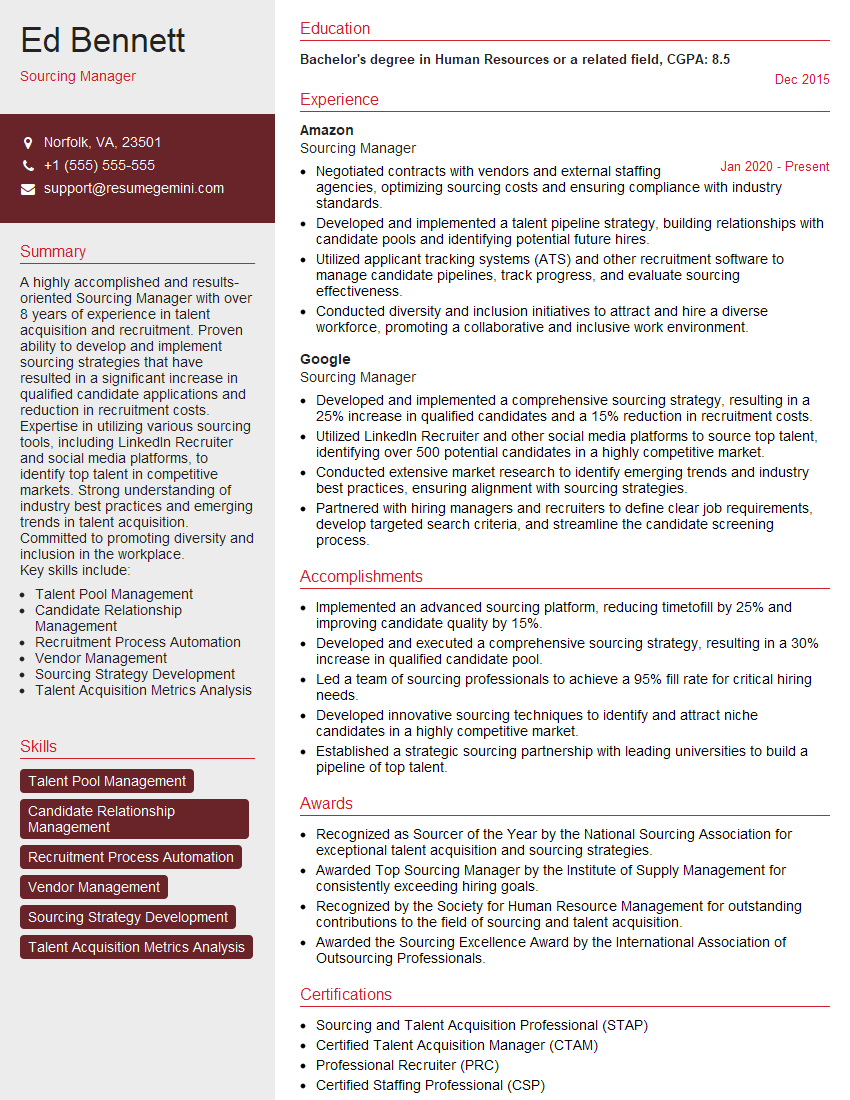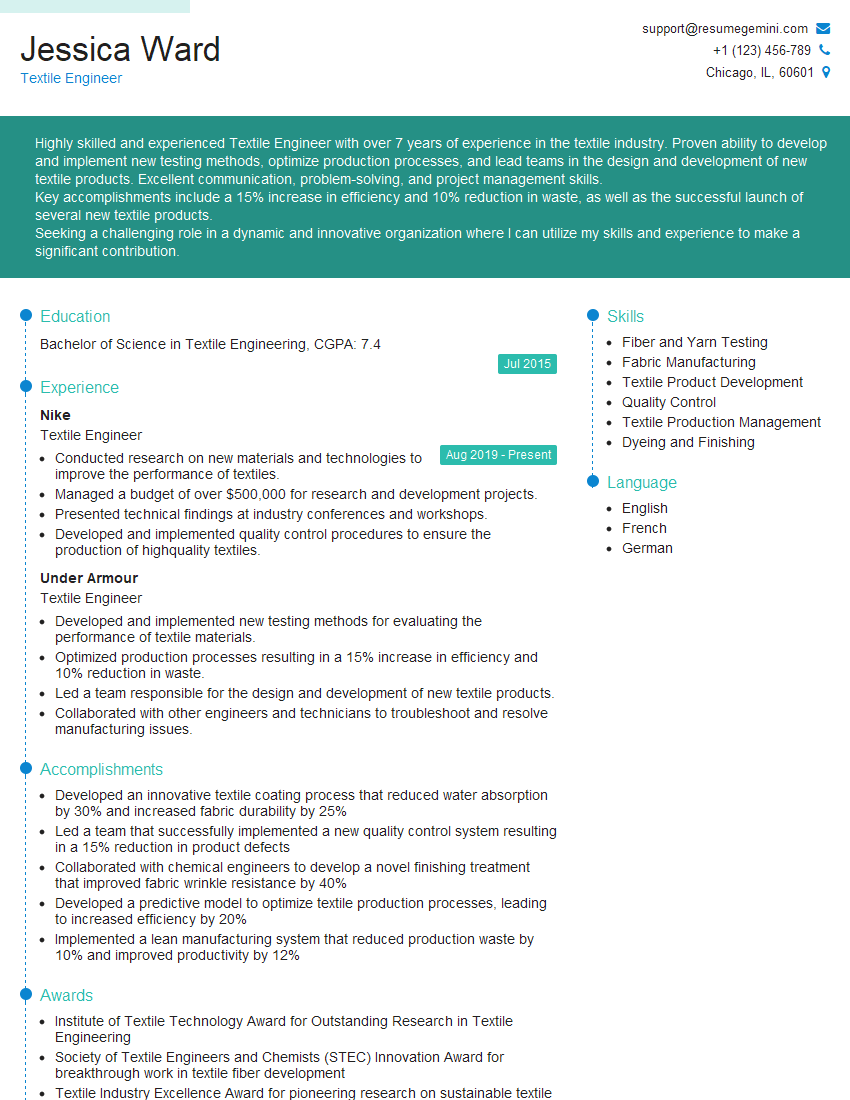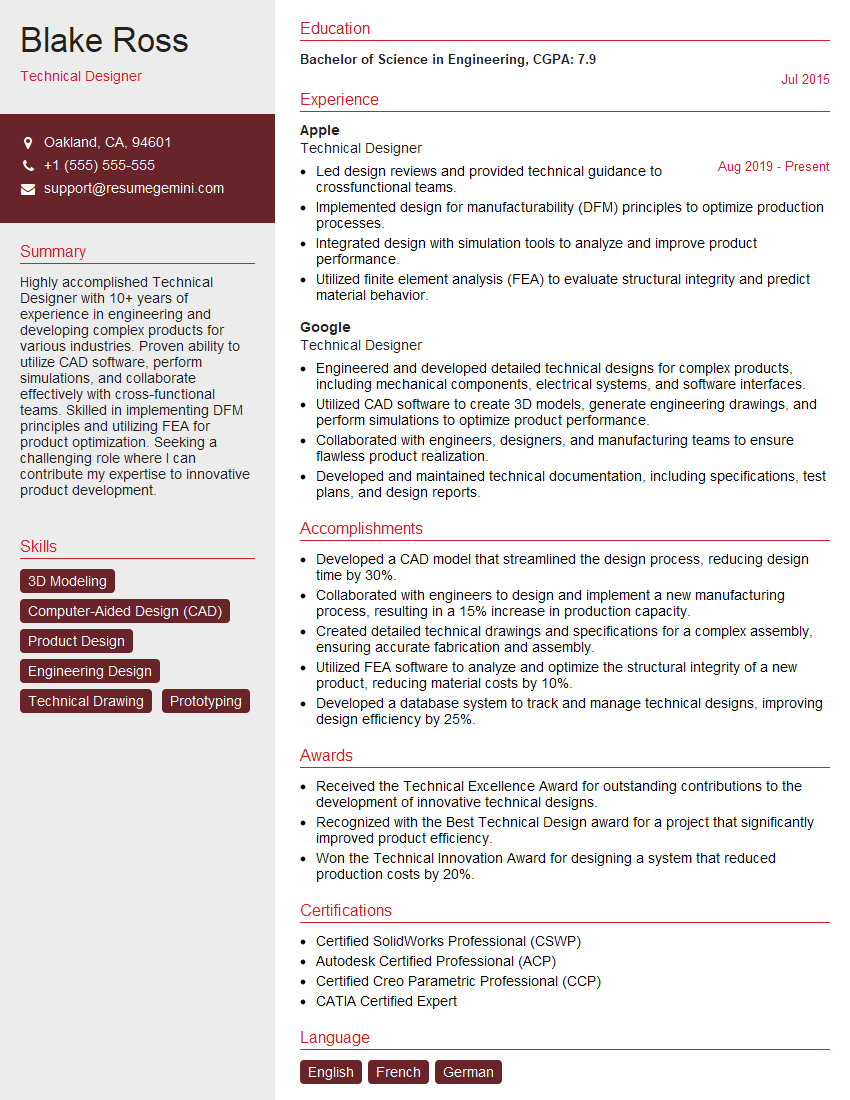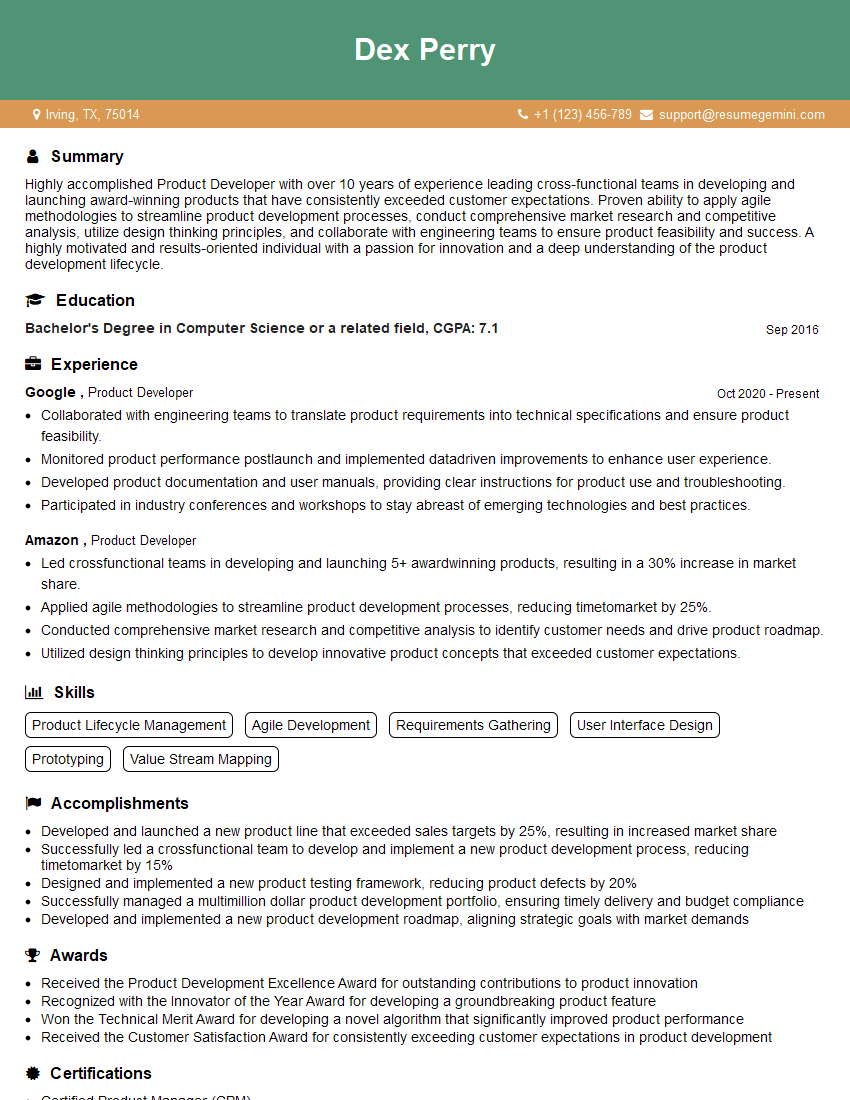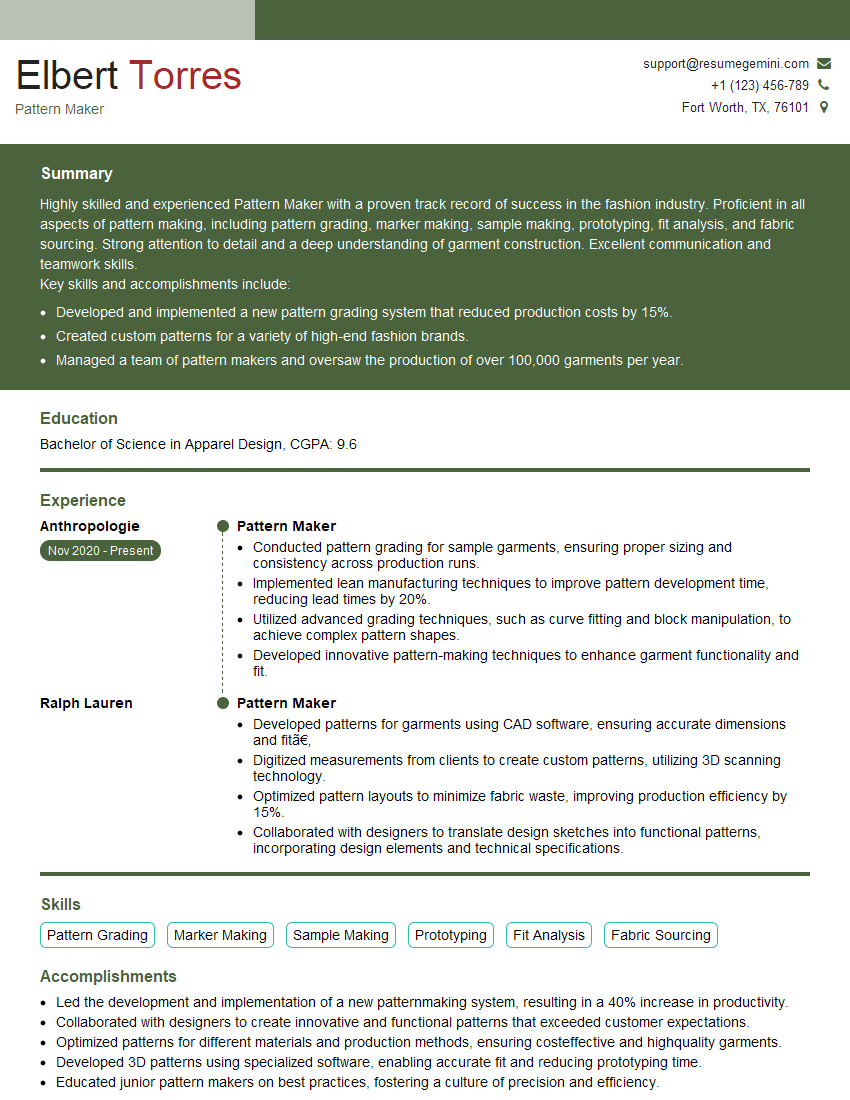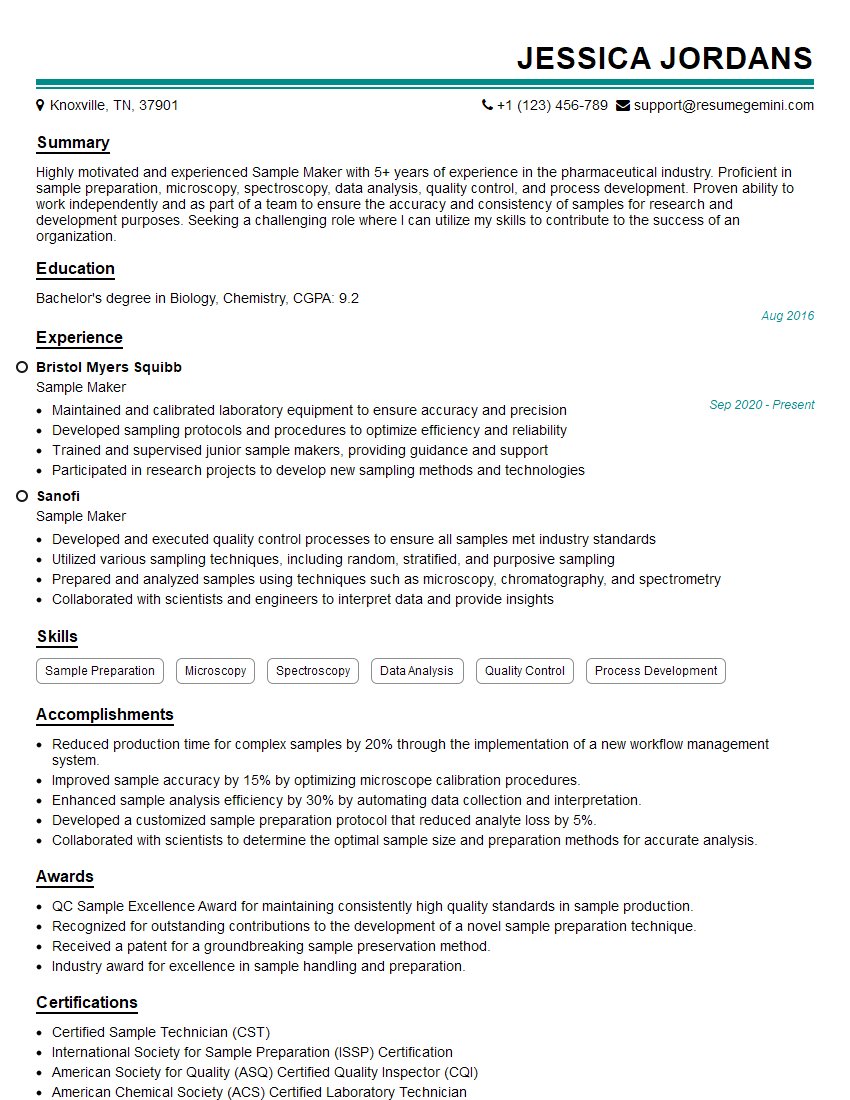Cracking a skill-specific interview, like one for Collar Interfacing Selection, requires understanding the nuances of the role. In this blog, we present the questions you’re most likely to encounter, along with insights into how to answer them effectively. Let’s ensure you’re ready to make a strong impression.
Questions Asked in Collar Interfacing Selection Interview
Q 1. What are the different types of collar interfacing?
Collar interfacing comes in two primary types: fusible and sew-in. Fusible interfacing is bonded to the fabric using heat and pressure from an iron, while sew-in interfacing is stitched directly to the collar fabric. Beyond this basic categorization, there’s a wide variety within each type based on weight, stiffness, and composition. For example, within fusible interfacings you’ll find options ranging from lightweight, soft interfacings ideal for delicate fabrics to heavy-duty, crisp interfacings perfect for structured collars. Similarly, sew-in interfacings offer a range of weights and textures. Choosing the right type depends heavily on the desired collar structure and the fabric being used.
Q 2. Describe the properties of fusible interfacing.
Fusible interfacing is characterized by its adhesive properties. It has a thermoplastic layer that activates when exposed to heat and pressure, creating a strong bond with the fabric. Key properties include its ease of application – simply iron it on – and its ability to provide varying degrees of support and structure depending on its weight and composition. A lighter fusible interfacing will add minimal structure, while a heavier one will create a more rigid collar. The adhesive strength and heat activation temperature can also vary, so it’s important to check the manufacturer’s instructions to avoid damaging the fabric. Think of it like a temporary glue, that becomes permanent when you apply heat.
Q 3. What are the advantages and disadvantages of sew-in interfacing?
Advantages of sew-in interfacing: Sew-in interfacing offers superior durability and precise placement. The stitching secures it firmly, preventing slippage or bubbling, especially beneficial for curved collars or complex designs. It also allows for more control over the collar’s final shape and can be easily adapted to accommodate intricate details.
Disadvantages of sew-in interfacing: It’s more time-consuming to apply than fusible interfacing, requiring extra stitching steps. This also increases the labor cost and complexity. Incorrect placement or uneven stitching can lead to visible imperfections.
Q 4. How do you select the appropriate interfacing weight for a particular collar style?
Interfacing weight selection is crucial for achieving the desired collar stand. A lightweight fabric like silk would require a lightweight interfacing to avoid creating an overly stiff or bulky collar. This would result in a softer, more pliable collar. Conversely, a heavier fabric like wool might need a medium-weight or even heavyweight interfacing to provide adequate support and prevent the collar from collapsing. A structured collar, such as a shirt collar, generally needs a heavier weight interfacing than a softer, more draped collar like a shawl collar. Always consider the overall look and feel you want to achieve.
Q 5. What factors influence your choice of interfacing color?
Interfacing color selection is primarily driven by minimizing its visibility through the outer fabric. Ideally, the interfacing should match the fabric color as closely as possible to prevent any unwanted color showing through, especially in lighter-colored garments. This is particularly important for collars, as they are a prominent feature of many garments. However, in certain instances, a contrasting color might be acceptable, especially when using a very sheer fabric where color matching perfectly is impossible. Transparency of the outer fabric is a major consideration here.
Q 6. How does the fabric weight of the collar influence interfacing selection?
The fabric weight of the collar significantly impacts interfacing choice. Heavier collar fabrics require heavier interfacing to maintain the collar’s shape and prevent it from sagging. Lighter fabrics, however, require lighter interfacing to avoid adding unnecessary bulk and stiffness. For instance, a heavy tweed collar might need a heavy-duty, woven interfacing, whereas a delicate lace collar might only need a lightweight fusible option or even no interfacing at all. It’s a balancing act: you want enough support to maintain the shape, but not so much that it distorts the fabric or feels uncomfortable.
Q 7. Explain the process of testing interfacing adhesion.
Testing interfacing adhesion is essential to ensure a secure bond and prevent the interfacing from separating from the fabric after washing or wear. A simple test involves applying the interfacing to a scrap of the garment fabric according to the manufacturer’s instructions. After the interfacing has cooled, gently try to peel it away from the fabric. A well-adhered interfacing should resist this effort. If it peels off easily, the heat wasn’t sufficient or the interfacing isn’t suitable for the fabric. Another method involves applying pressure and then pulling on the interfacing after it has cooled; again, it should not separate. Finally, you can also test for wash-ability by washing the test piece to assess the strength of the bond after exposure to water.
Q 8. How do you address interfacing issues such as puckering or wrinkling?
Puckering and wrinkling in collars are common interfacing issues stemming from improper interfacing selection or application. Think of it like trying to fit a square peg in a round hole; the wrong interfacing creates tension and distortion.
Addressing these issues involves a multi-pronged approach:
- Choosing the right interfacing: Select an interfacing with a similar drape and weight to the collar fabric. Too stiff an interfacing will pull and pucker; too flimsy will lack support and wrinkle.
- Proper application: Ensure the interfacing is applied smoothly and evenly, avoiding wrinkles or air bubbles. Use a pressing cloth to protect the fabric and distribute heat evenly. This is crucial, especially with fusible interfacings.
- Careful seam allowance: Generous seam allowances can help distribute stress and reduce puckering. This is particularly important at the collar points and stand.
- Pattern adjustments: Sometimes the pattern itself contributes to puckering. Check for ease and fit in the collar area. Consider grading the seam allowances, particularly at the points where the collar meets the garment.
- Pressing techniques: Press seams open carefully and use a tailor’s ham or sleeve roll to shape the collar correctly.
For example, a lightweight silk collar might require a lightweight, woven interfacing, while a heavier wool might benefit from a heavier, possibly non-woven, interfacing.
Q 9. What is the role of interfacing in collar shaping and support?
Interfacing is the unsung hero of collar construction, providing the crucial structure and shape that keeps a collar looking crisp and professional. Think of it as the skeleton providing support for the outer fabric (the skin).
Its role in collar shaping and support is multifaceted:
- Shape Retention: Interfacing provides the necessary firmness to maintain the intended shape of the collar, preventing it from collapsing or losing its form. It holds the collar points neatly and prevents them from flopping.
- Support: It reinforces the collar fabric, preventing stretching and distortion. This ensures a clean, defined line along the neckline.
- Smooth Finish: The interfacing creates a smooth surface, making the collar look more polished and professional. It prevents unsightly wrinkles or bumps.
- Structural Integrity: Interfacing strengthens the collar’s construction, making it more durable and resistant to wear and tear.
Without the correct interfacing, a collar can appear limp, shapeless, and unprofessional.
Q 10. Describe different methods for applying fusible interfacing.
Applying fusible interfacing requires precision and attention to detail. The goal is to create a bond that’s strong but doesn’t distort the fabric.
Here are common methods:
- Ironing: This is the most common method. Set your iron to the appropriate temperature (always test on a scrap first!), place the interfacing on the wrong side of the fabric, cover with a pressing cloth, and press firmly for the recommended time. Avoid sliding the iron, which can cause uneven bonding.
- Steam Pressing: Steam can help achieve a more even bond, particularly for delicate fabrics. Use a low-pressure steam setting and avoid direct steam on the fabric.
- Pressing Cloth: Using a pressing cloth is essential to protect the fabric from scorching or shine. A lightweight, clean cotton fabric is ideal.
- Low-Temperature Settings: Even with fusible interfacing, always start with a low temperature to avoid damaging your fabric. Higher temperatures should be used only if necessary.
- Using a Tailor’s Ham/Sleeve Roll: When interfacing curved collars, using a tailor’s ham or sleeve roll can help prevent distortions or puckering during pressing.
Remember to check the interfacing manufacturer’s instructions for specific application guidelines.
Q 11. How does the fiber content of the collar fabric affect interfacing choice?
The fiber content of the collar fabric is a crucial factor in interfacing selection. The goal is to achieve a harmonious balance – the interfacing should complement the fabric’s drape, weight, and hand.
Examples:
- Lightweight Fabrics (silk, linen): Require lightweight, soft interfacings like woven or lightweight fusible interfacings. Heavier interfacings will create stiffness and distortion.
- Medium-Weight Fabrics (cotton, cotton blends): Can handle a wider range of interfacings, including medium-weight woven or fusible options. The choice depends on the desired level of support.
- Heavyweight Fabrics (wool, tweed): Need heavier, more substantial interfacings, potentially non-woven or heavy fusible options, to maintain shape and structure.
Ignoring this crucial relationship will lead to ill-fitting and unattractive collars.
Q 12. What are the implications of using inappropriate interfacing?
Using inappropriate interfacing can have several detrimental consequences, significantly impacting the overall quality and appearance of the garment. It’s like trying to build a house with the wrong materials—the structure suffers.
Implications of using the wrong interfacing include:
- Puckering and Wrinkling: The most common result, as discussed previously, is caused by incompatibility in weight and drape.
- Loss of Shape: A too-light interfacing won’t provide adequate support, leading to a limp and shapeless collar.
- Stiffness and Bulkiness: Too heavy or stiff an interfacing will create an unnatural stiffness and bulkiness, making the collar uncomfortable and unattractive.
- Uneven Appearance: Poor bonding or improper application can lead to an uneven and unprofessional finish.
- Reduced Durability: The collar will be less durable and prone to damage.
These issues ultimately compromise the garment’s aesthetic appeal and longevity.
Q 13. How do you determine the correct interfacing placement?
Correct interfacing placement is paramount for a well-structured collar. It’s not just about sticking it on; it’s about strategic positioning.
The general rule is to apply the interfacing to the *wrong side* of the collar pieces, typically extending it to the seam allowances. The amount of extension will depend on the pattern and the type of interfacing used.
Specific considerations:
- Collar Stand: Interfacing the entire collar stand is generally recommended for maximum support and structure.
- Collar Points: Careful interfacing around the collar points is crucial for creating a sharp, defined shape. Ensure the interfacing is securely bonded to avoid points flipping out.
- Collar Roll Line: Depending on the pattern, the interfacing might extend beyond the seam line to help with collar roll.
- Seams: The interfacing should usually extend slightly beyond the seam lines to provide support during stitching and pressing.
Always refer to the pattern instructions, as placement can vary depending on the design.
Q 14. What are the common challenges associated with collar interfacing selection?
Selecting the right collar interfacing can present various challenges, often requiring a thorough understanding of fabric properties and interfacing types.
Common challenges include:
- Matching Drape and Weight: Finding an interfacing with a drape and weight that complements the collar fabric perfectly is a constant balancing act.
- Choosing Between Fusible and Sewn: Fusible interfacings offer convenience, but sewn interfacings can sometimes provide better control and a more tailored finish. The choice depends on skill, project requirements, and fabric type.
- Achieving the Correct Level of Support: Finding the right balance between sufficient support and avoiding excessive stiffness or bulk can be tricky.
- Managing Different Fabric Types: Working with a variety of fabrics, each with unique properties, requires adaptability in interfacing selection.
- Avoiding Puckering and Wrinkling: This remains a persistent challenge, requiring careful selection, application, and pressing techniques.
Overcoming these challenges requires a deep understanding of fabric science, interfacing properties, and advanced sewing skills. It’s a learned skill that gets honed with experience.
Q 15. Describe your experience troubleshooting collar interfacing problems.
Troubleshooting collar interfacing issues often involves a systematic approach. I start by identifying the specific problem – is the collar too stiff, too floppy, puckering, or rolling? Then, I analyze the contributing factors: the type of interfacing used, its application method, the fabric’s properties, and the sewing techniques.
For instance, if a collar is too stiff, the interfacing might be too heavy or too tightly fused. I would then consider switching to a lighter-weight fusible interfacing or adjusting the fusing temperature and pressure to achieve a softer result. Conversely, a floppy collar might indicate an interfacing that’s too lightweight or poorly adhered. In this case, I’d explore using a heavier interfacing or a non-fusible option applied with precise hand-stitching. Puckerings often point to uneven application of heat or pressure during fusing, or incorrect placement of the interfacing. Careful attention to placement and using a pressing cloth are key to avoiding this. Rolling usually indicates that the interfacing is too bulky or the seam allowances aren’t properly finished, and it can be addressed with interfacing that is better suited to the collar fabric or reshaping the seam allowances.
I keep detailed records of each troubleshooting process, including the type of fabric, interfacing used, and any adjustments made. This allows for continuous improvement and helps me quickly address similar problems in the future.
Career Expert Tips:
- Ace those interviews! Prepare effectively by reviewing the Top 50 Most Common Interview Questions on ResumeGemini.
- Navigate your job search with confidence! Explore a wide range of Career Tips on ResumeGemini. Learn about common challenges and recommendations to overcome them.
- Craft the perfect resume! Master the Art of Resume Writing with ResumeGemini’s guide. Showcase your unique qualifications and achievements effectively.
- Don’t miss out on holiday savings! Build your dream resume with ResumeGemini’s ATS optimized templates.
Q 16. How do you ensure consistent interfacing application across production runs?
Consistency in interfacing application across production runs is paramount for maintaining quality and minimizing waste. My approach involves a multi-pronged strategy focusing on standardization, training, and quality control.
First, we use standardized procedures with detailed written instructions, including precise measurements, fusing temperatures, and pressing techniques. These instructions are supplemented by clear visual aids, such as diagrams and photographs, to leave no room for ambiguity. Secondly, we invest in consistent equipment—fusing machines that maintain a constant temperature and pressure are crucial. Regular calibration and maintenance of this equipment are also essential. We also train our team thoroughly, ensuring they understand the importance of following procedures and identifying any inconsistencies. Regular quality control checks are performed throughout the production process, with samples inspected visually for correct fusing and any defects. Finally, we track production data, such as interfacing usage and defect rates, to pinpoint areas for improvement and maintain consistent high quality.
Q 17. What is the importance of considering the drape of the collar fabric?
Considering the drape of the collar fabric is critical for selecting the right interfacing. The interfacing’s stiffness should complement the fabric’s drape, not fight against it. A heavy, crisp fabric like linen will require a sturdy interfacing to maintain its shape, while a soft, flowing fabric like silk might need a lightweight, flexible interfacing to prevent the collar from appearing stiff or unnatural.
For example, using a stiff interfacing with a lightweight silk fabric would result in a rigid, unnatural collar that doesn’t drape well. Similarly, using a lightweight interfacing with a heavy linen fabric could result in a collar that lacks structure and collapses.
Understanding the interplay between fabric drape and interfacing support is essential for achieving a well-finished, flattering collar.
Q 18. How do you account for shrinkage when selecting and applying interfacing?
Accounting for shrinkage is crucial to prevent the collar from becoming misshapen after washing or cleaning. We address shrinkage in two main ways: pre-shrinking and using shrinkage-controlled interfacing.
First, we pre-shrink the fabric before cutting and applying interfacing. This involves washing and drying the fabric according to its care instructions to remove any potential shrinkage before cutting patterns. Second, we select interfacings that are designed for minimal shrinkage or are already pre-shrunk. Many interfacing manufacturers offer options specifically designed to resist shrinkage, ensuring the collar maintains its shape after washing. Using pre-shrunk interfacings and properly pre-shrinking the outer fabric minimize the risk of post-production shrinkage issues.
Q 19. What are the environmental considerations related to interfacing selection?
Environmental considerations are increasingly important in interfacing selection. This includes choosing interfacings made from sustainable materials, such as recycled fibers or organic cotton, and considering the manufacturing processes. We look for interfacings with certifications such as OEKO-TEX Standard 100, which guarantees the absence of harmful substances.
Furthermore, we evaluate the interfacing’s overall environmental impact, including its transportation and disposal. Biodegradable interfacings are becoming more prevalent and offer a more environmentally friendly option compared to traditional synthetics. Reducing waste through precise cutting and minimizing material usage is also critical in our efforts to minimize environmental impact.
Q 20. How do you balance cost and quality when choosing interfacing?
Balancing cost and quality in interfacing selection requires a careful evaluation of the project’s requirements and overall budget. While cheaper interfacings are tempting, selecting a subpar option can compromise the quality of the finished garment and lead to higher costs in the long run due to rework or customer returns.
My approach involves comparing the cost-per-unit of different interfacing options with their performance characteristics. A slightly more expensive interfacing that provides superior support, durability, and a better drape might be a more cost-effective choice in the long run than a cheaper alternative that doesn’t meet the necessary quality standards. For example, a high-quality interfacing that doesn’t require as much labor to sew correctly might balance out the higher material cost, especially for high-volume productions.
Ultimately, the goal is to find an interfacing that delivers the necessary quality without excessive cost, aligning with the garment’s overall value proposition.
Q 21. What is your experience with different types of adhesives used in interfacing?
My experience encompasses a range of adhesives used in interfacing, including fusible and non-fusible options. Fusible interfacings use heat-activated adhesives that bond the interfacing to the fabric during the fusing process. The type of adhesive affects the fusing temperature and pressure needed, influencing the stiffness and final drape of the collar. Some fusible adhesives are more aggressive, offering a strong bond, while others are milder, suitable for delicate fabrics.
Non-fusible interfacings, on the other hand, require hand-stitching or machine stitching to attach them to the fabric. These offer greater flexibility in tailoring the collar’s stiffness and also allow for more intricate shaping. The choice of adhesive, whether fusible or non-fusible, impacts the overall construction process and the final product, necessitating a careful selection based on the fabric type, collar style, and desired outcome.
Q 22. How do you address interfacing issues related to different wash and care instructions?
Addressing interfacing issues related to wash and care instructions requires careful consideration of the interfacing’s properties and its compatibility with the fabric. The goal is to ensure the interfacing maintains its structural integrity and doesn’t cause the garment to distort or degrade after washing.
For example, if a garment requires dry cleaning, you’d select a dry-cleanable interfacing. Using a fusible interfacing that’s not dry-cleanable could result in the interfacing separating from the fabric or causing the fabric to yellow or shrink. Similarly, for machine-washable garments, choose an interfacing that’s specifically designed to withstand repeated washing and drying cycles. Look for interfacings labeled as ‘wash-and-wear’ or with specific washing temperature recommendations. Using a non-washable interfacing in a machine-washable garment will almost certainly lead to failure.
A crucial step is always checking the manufacturer’s specifications for both the fabric and the interfacing. This information provides vital clues about appropriate cleaning methods and temperature settings to prevent issues.
Q 23. What are some alternative materials that can be used instead of interfacing?
While interfacing is a common choice for adding structure and support, several alternatives can be used, depending on the desired effect and the fabric’s properties.
- Underlining: A lightweight fabric, often sheer, that’s sewn to the wrong side of the fashion fabric. This provides subtle body and drape improvement, perfect for delicate fabrics like silk or chiffon.
- Self-lining: Using the same fabric as the garment’s exterior to create a lining. This offers good support and a clean finish, often used in jackets or tailored garments.
- Fusible web: A less stiff alternative to traditional interfacing; ideal for lightweight fabrics where you need minimal stiffness. It provides more of a fusing and stabilization effect rather than creating a rigid structure.
- Horsehair braid: Traditionally used in tailoring for stiffening edges like collars and cuffs. This provides a firm edge without the bulk of a traditional interfacing.
The choice depends entirely on the garment’s style and fabric; sometimes a combination of these methods is ideal.
Q 24. Explain how interfacing selection impacts the overall garment durability.
Interfacing selection significantly impacts garment durability. Choosing the wrong interfacing can lead to premature failure, while the right choice ensures the garment retains its shape and structure over time.
For instance, using a lightweight interfacing in a heavy-duty garment like a work jacket will result in the collar or cuffs losing their shape quickly. Conversely, using a heavy-duty interfacing in a delicate blouse might result in an excessively stiff and unnatural feel. The interfacing should be appropriately matched to the weight and drape of the main fabric. A good rule of thumb is to match the weight of the interfacing to the weight of the fabric it supports. A heavier fabric requires a heavier interfacing for long-lasting support.
Furthermore, the interfacing’s construction affects durability. Fusible interfacings, while convenient, can lose their adhesion over time, especially with repeated washing or dry cleaning. Sewn interfacings generally offer better long-term durability.
Q 25. How do you determine if a specific interfacing is suitable for a particular garment?
Determining the suitability of a specific interfacing involves a multi-step process that considers several key factors:
- Fabric Weight and Drape: Match the weight and hand (feel) of the interfacing to the fabric. Lightweight fabrics need lightweight interfacing, and vice-versa.
- Fabric Composition: Consider the fiber content. Natural fibers might require a different interfacing than synthetics. Certain interfacings may react differently with specific fabrics during washing.
- Garment Style and Construction: The garment’s intended use and design affect the required level of support and stiffness. A structured jacket requires a more robust interfacing than a flowing blouse.
- Washing Instructions: The interfacing should be compatible with the fabric’s care instructions. Choose a dry-cleanable interfacing for dry-clean only garments.
- Testing: Before committing to a large project, always test the interfacing on a scrap piece of the main fabric. Assess the adhesion, stiffness, and overall appearance to ensure compatibility.
By systematically evaluating these factors, you can significantly improve the success rate of your projects and ensure the durability of the final garment.
Q 26. What are the latest trends in interfacing technology and materials?
The interfacing industry continuously evolves, introducing innovative materials and technologies. Some notable trends include:
- Eco-friendly Interfacings: Growing demand for sustainable options is leading to the development of interfacings made from recycled materials or organic fibers, minimizing environmental impact.
- Stretch Interfacings: These adapt well to knit fabrics, offering support and shape retention without restricting movement. They’re particularly beneficial for activewear or garments designed for comfort and flexibility.
- High-Performance Interfacings: Designed for specialized applications, these interfacings offer exceptional durability, water resistance, or other specific performance features.
- Innovative Bonding Technologies: Advances in adhesive technologies enhance the bonding strength and washing durability of fusible interfacings.
These advancements provide garment makers with more options to achieve superior results tailored to their specific needs.
Q 27. Describe your experience working with both woven and knit fabrics in relation to interfacing selection.
My experience working with both woven and knit fabrics emphasizes the critical importance of selecting the appropriate interfacing. Woven fabrics generally require a stiffer, more structured interfacing to maintain their shape. The choice often depends on the weave’s density and the garment style. For example, a crisp cotton shirt would benefit from a firm cotton or linen interfacing, while a more loosely woven fabric might need a lighter-weight, less stiff option.
Knit fabrics, on the other hand, often require a more flexible interfacing. Rigid interfacings can cause puckering or distort the knit’s natural drape. Stretch interfacings, with their flexibility and elasticity, are the ideal solution for most knit garments, ensuring the garment maintains its shape without restricting the fabric’s movement. The choice might also depend on the knit’s weight and stretch properties.
In either case, thorough testing with scrap fabric remains crucial to ensure a successful outcome.
Q 28. What are some quality control measures you would implement to ensure consistent results with interfacing applications?
Implementing robust quality control measures is paramount to achieving consistent results with interfacing applications. My approach focuses on several key areas:
- Material Sourcing and Storage: Using interfacings from reputable suppliers and storing them correctly to maintain quality and prevent degradation.
- Pre-cutting Inspection: Checking for defects in the interfacing before cutting to prevent flawed garments.
- Application Consistency: Maintaining consistent pressure and temperature (for fusible interfacings) or stitch length (for sewn interfacings) during application.
- Testing and Quality Checks at Key Stages: Inspecting the finished garment components (e.g., collars, cuffs) for proper adhesion, fit, and shape to ensure the interfacing has performed its intended function correctly.
- Record Keeping: Documenting interfacing types, application methods, and any observations or adjustments made during the process. This aids in troubleshooting and process improvements.
By integrating these steps, you can maintain a high level of consistency and minimize the risk of inconsistencies, thus producing garments of superior quality.
Key Topics to Learn for Collar Interfacing Selection Interview
- Understanding Collar Types and Their Construction: Explore the various collar types (e.g., shirt collars, mandarin collars, etc.) and their unique construction methods. Consider the implications of different collar styles on interfacing selection.
- Interfacing Materials and Properties: Become familiar with the properties of different interfacing materials (e.g., fusible, sew-in, woven, non-woven). Understand how these properties (stiffness, drape, weight) impact the final collar structure and its overall look.
- Choosing the Right Interfacing: Learn the criteria for selecting the appropriate interfacing for a specific collar type and fabric. This includes considering fabric weight, drape, and the desired level of collar support and structure.
- Application Techniques: Master the proper techniques for applying different types of interfacing to collars, ensuring a clean, professional finish. Consider different application methods and their impact on the final product.
- Troubleshooting Common Issues: Familiarize yourself with common problems encountered during collar interfacing (e.g., puckering, wrinkles, uneven adhesion) and develop strategies for troubleshooting and preventing these issues.
- Sustainability and Ethical Sourcing of Materials: Explore the environmental impact of interfacing materials and the importance of choosing sustainable and ethically sourced options. This demonstrates awareness of industry trends and responsible practices.
Next Steps
Mastering collar interfacing selection is crucial for career advancement in the apparel industry, demonstrating your attention to detail and understanding of garment construction. A well-crafted resume is your key to unlocking exciting opportunities. To significantly increase your chances of getting noticed by Applicant Tracking Systems (ATS) and recruiters, build an ATS-friendly resume. ResumeGemini is a trusted resource to help you create a professional and impactful resume that highlights your skills and experience effectively. Examples of resumes tailored to Collar Interfacing Selection are available to guide you further.
Explore more articles
Users Rating of Our Blogs
Share Your Experience
We value your feedback! Please rate our content and share your thoughts (optional).
What Readers Say About Our Blog
Hello,
We found issues with your domain’s email setup that may be sending your messages to spam or blocking them completely. InboxShield Mini shows you how to fix it in minutes — no tech skills required.
Scan your domain now for details: https://inboxshield-mini.com/
— Adam @ InboxShield Mini
Reply STOP to unsubscribe
Hi, are you owner of interviewgemini.com? What if I told you I could help you find extra time in your schedule, reconnect with leads you didn’t even realize you missed, and bring in more “I want to work with you” conversations, without increasing your ad spend or hiring a full-time employee?
All with a flexible, budget-friendly service that could easily pay for itself. Sounds good?
Would it be nice to jump on a quick 10-minute call so I can show you exactly how we make this work?
Best,
Hapei
Marketing Director
Hey, I know you’re the owner of interviewgemini.com. I’ll be quick.
Fundraising for your business is tough and time-consuming. We make it easier by guaranteeing two private investor meetings each month, for six months. No demos, no pitch events – just direct introductions to active investors matched to your startup.
If youR17;re raising, this could help you build real momentum. Want me to send more info?
Hi, I represent an SEO company that specialises in getting you AI citations and higher rankings on Google. I’d like to offer you a 100% free SEO audit for your website. Would you be interested?
Hi, I represent an SEO company that specialises in getting you AI citations and higher rankings on Google. I’d like to offer you a 100% free SEO audit for your website. Would you be interested?
good

